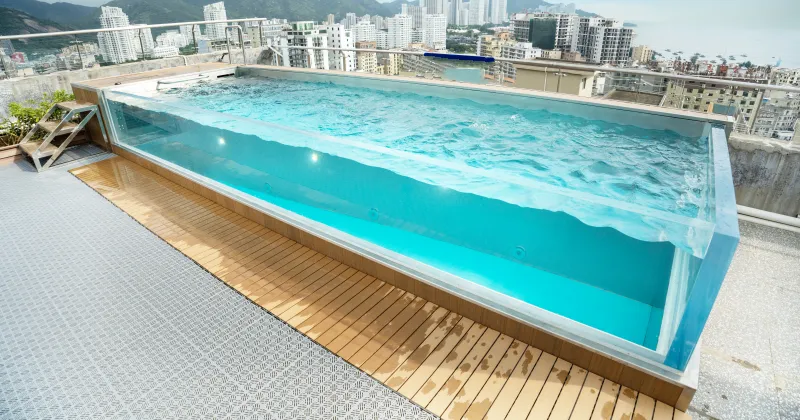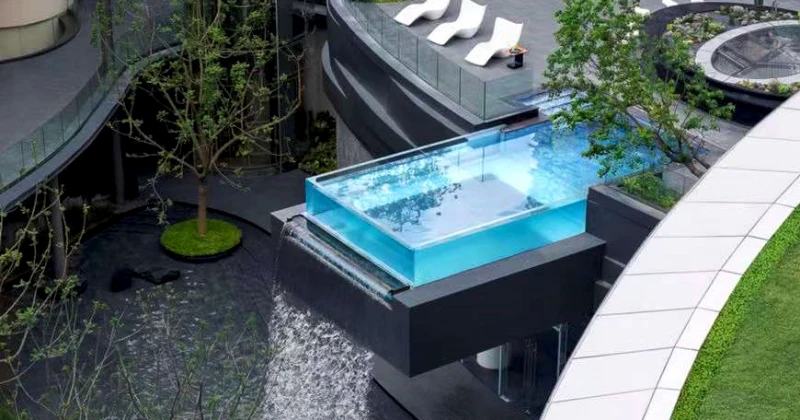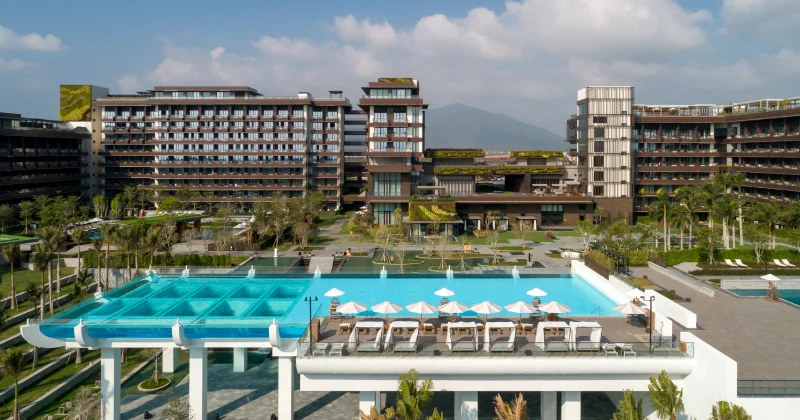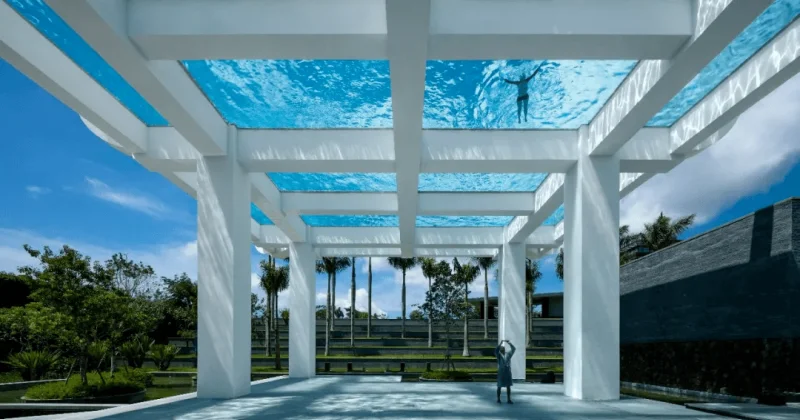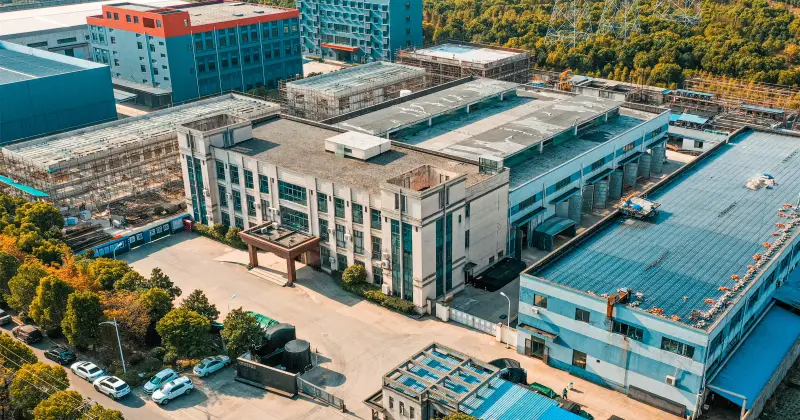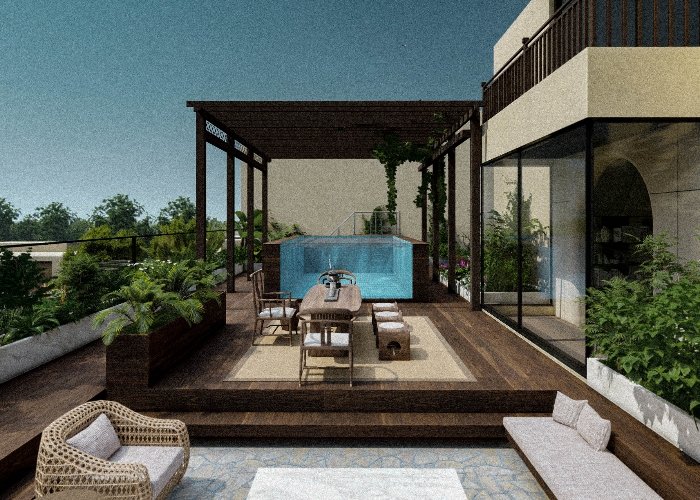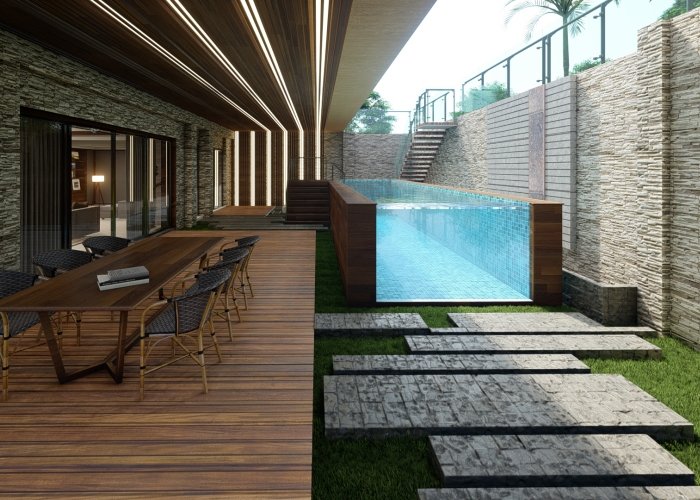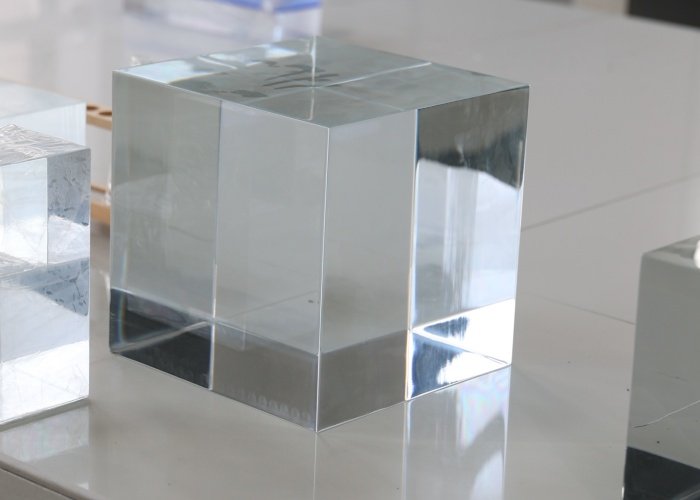
Pool Acrylic Panels VS Pool Glass Walls
With the increasing frequency of glass-walled pools in daily life, many people are drawn to these partially transparent pools through hotels, social media, and other channels. They appear like transparent glass, but in fact, most glass-walled pools don't use real glass; they just look like it. The actual material used is acrylic, a polymer material.
Poly (methyl methacrylate) (PMMA) is a synthetic polymer derived from methyl methacrylate. It is used as an engineering plastic, and it is a transparent thermoplastic. PMMA is also known as acrylic or acrylic glass, this plastic is often used in sheet form as a lightweight or shatter-resistant alternative to glass.
We have received numerous inquiries about using tempered glass for glass-walled pools, and our consistent response has always been: No, no, no—never use tempered glass as a substitute for acrylic panels to create a transparent acrylic swimming pool. Even though tempered glass can be made thicker through lamination, and although glass is much cheaper than acrylic, we consistently emphasize not using tempered glass to make glass-walled pools. Below, we'll compare the advantages of glass walls and acrylic panels:
Properties
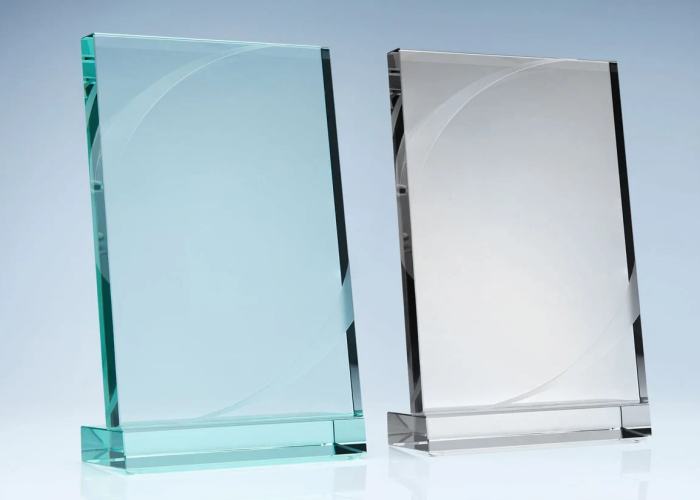
Low Iron (right) vs. Clear Glass (left) Comparison(Image Source: dillmeierglass)
Transparency
Glass: Typically, clear glass still retains its greenish tint, which becomes more pronounced with thicker glass. Most standard transparency percentages are around 85%. Low-iron glass, also known as ultra-clear glass or optical clear glass, can provide the highest transparency. Float glass manufacturers produce low-iron glass by reducing the iron content in the molten glass formula. This type is more transparent than regular glass and lacks the greenish tint. Altering the iron content can increase light transmittance by 5% to 6%."
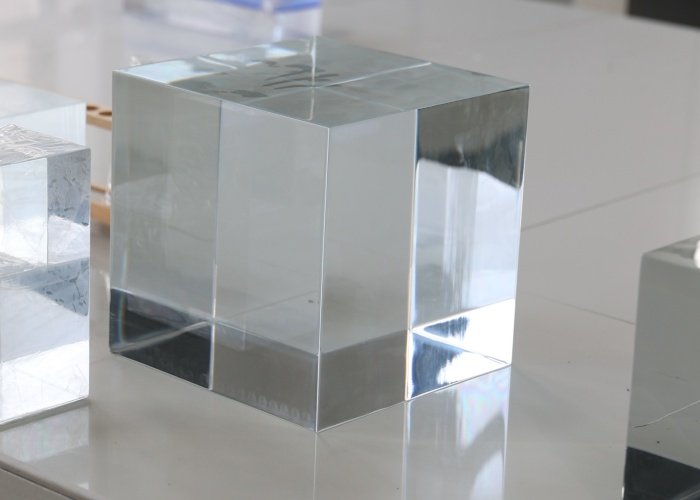
Acrylic: Acrylic panels produced through strict raw material selection, advanced formulation updates, and modern production processes exhibit excellent transparency and whiteness. They appear crystal clear after flame polishing. Acrylic panels manufactured by Aupool can ensure 93% transparency.
In terms of transparency, there doesn't seem to be a significant difference between glass and acrylic. This is also why many people refer to acrylic pools as glass-walled pools.
Density
Glass: Density ranges from 2.40 to 2.80 grams per cubic centimeter (g/cm^3), making the mass of flat glass approximately 2.5 kilograms per square meter per millimeter thickness, or 2500 kilograms per square meter.
Acrylic: Density ranges from 1.17 to 1.20 g/cm^3, less than half of glass. This gives acrylic more advantages in terms of installation and transportation compared to glass.
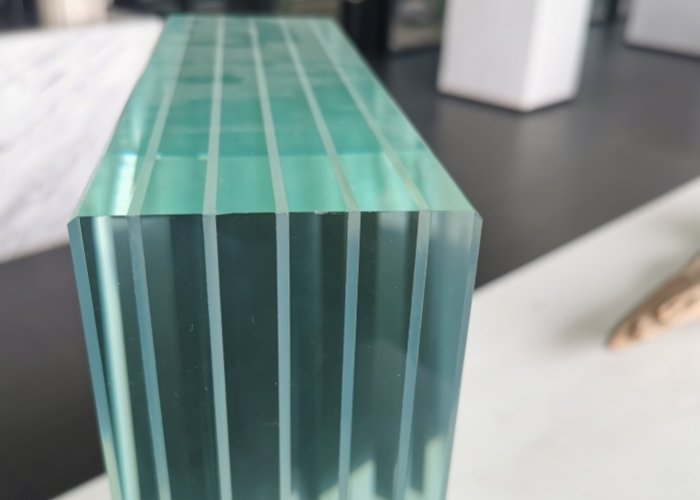
Six-layer laminated glass
Strength
Glass: Glass is a perfectly elastic material; it does not exhibit permanent deformation until it breaks. However, it is fragile and will break without warning if subjected to excessive stress. Anyone who has ever broken glass in the kitchen can tell you how fragile glass is, and we often handle it with great care during use.
Some glass-walled pools use laminated glass, which is a type of safety glass consisting of two or more layers of glass with one or more thin polymer interlayers between them. This construction prevents the glass from breaking into large sharp pieces. When broken, it produces a characteristic 'spider web' cracking pattern (radial and concentric cracks) when the impact is not enough to completely pierce the glass. However, it does not prevent the glass from breaking; it only prevents the glass from shattering into sharp pieces that could injure people. But using it in a pool is not safe, as it means the water in the pool will pour out, resulting in significant damage.
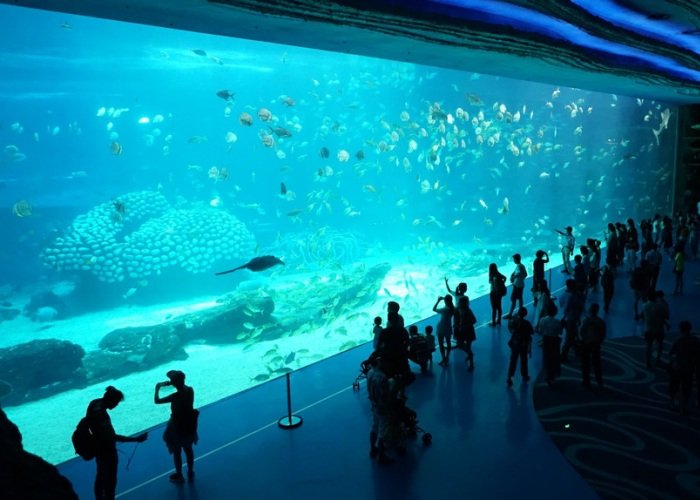
The world's largest acrylic transparent window in the aquarium: with 129.6 feet in length, 27.25 feet in height, and 2.13 feet in thickness.
Acrylic: Acrylic is a robust and resilient material with excellent impact strength, more toughness than glass, and 16 times the impact resistance of tempered glass. As a flexible material, it has excellent resistance to bending and fracture. Under strong pressure, acrylic panels only bend and do not shatter like glass. This is why, during World War II, many countries' military forces used acrylic glass to manufacture submarine periscopes, aircraft windshields, cockpit canopies, and gun turrets.
In situations with comparable transparency, materials used for transparent barriers prioritize impact resistance, tensile strength, flexural strength, and toughness over hardness and heat resistance. This is why nearly all global aquariums and a majority of glass-walled pool facilities opt for acrylic panels instead of the more affordable laminated glass. In these contexts, safety always takes precedence.
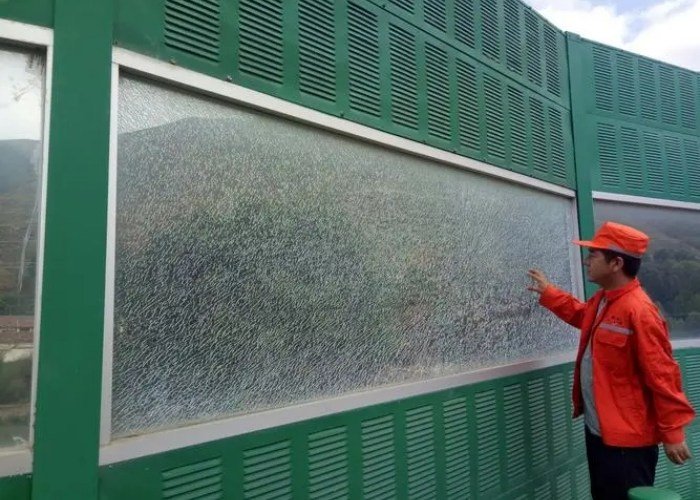
Spontaneous glass breakage
Spontaneous glass breakage is a phenomenon by which toughened glass (or tempered) may spontaneously break without any apparent reason.
the controllable characteristics of tempered glass tempered glass explode reason for unclear explosion problem, the responsibility is difficult to understand. Self-time no uncertainty may be just released, and may also be manufactured from 1 to February, there are 1 to 2 years before the factory explosion, causing more tempered glass blow time may be the production after the completion of the 4 ~ 5 years.
It is not fully understood, that the probability of most manufacturer's products is around 3 of the explosive rates; the probability of individual manufacturers of products may be even higher.
The fundamental reason is that glass blown glass contains nickel sulfide and heterogeneous particle impurities, impurity is how they mix. It is not yet clear how glass is mixed into nickel. The most probable source is all kinds of nickel alloy parts used on equipment and various heat-resistant alloys used in furnaces. For the oil-burning furnace, it was reported that the condensate rich in nickel was found in a small furnace. Sulfur is unquestionably derived from the sulfur content in the mixture and the fuel. When the temperature is over 1000 C, nickel sulfide exists in molten glass in the form of droplets, and the curing temperature of these small droplets is 797. 1 gram of nickel sulfide can produce about 1000 small stones with a diameter of 0.15mm. Nickel sulfide can occur at any time after the production is completed, so it cannot be eliminated. There has been no effective way to prevent it from being called the "cancer of glass curtain wall".
Acrylic, on the other hand, is highly stable and finds its presence in various scenarios requiring toughness and strength. For instance, riot control vehicles often replace ordinary glass with acrylic to protect occupants from thrown objects. Acrylic is also used for the ceiling of the Houston Museum of Natural Science.
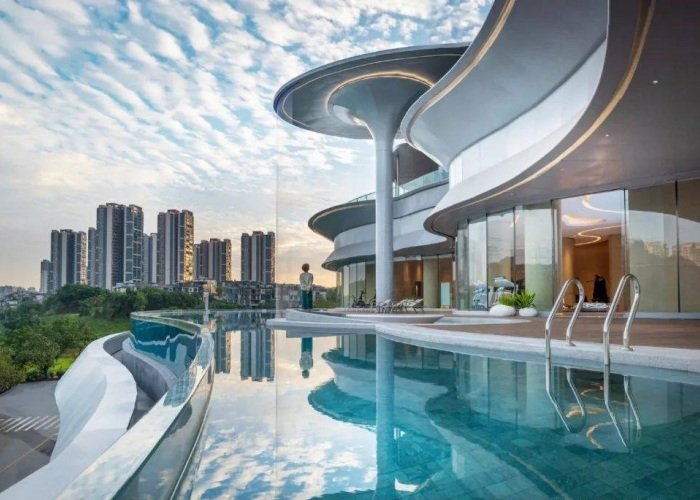
A 215-foot curved acrylic glass wall
More Versatile
Under normal circumstances, tempered glass cannot be reprocessed once the factory completes its production. Any cutting or impact can cause it to shatter as a whole. This means that for some large projects exceeding the maximum size of glass production, splicing is the only option. However, this results in an incomplete and imperfect appearance.
In dealing with specific projects, such as glass walls requiring bending, glass is often inadequate. After glass bending, the thickness at the curved portion becomes uneven, indicating that the weakest point is most susceptible to breakage, posing a significant safety risk.
Acrylic, on the other hand, has excellent processing capabilities. Even on-site, if you find dimensions slightly exceeding expectations, it can be cut with almost no impact. For unique projects, acrylic can be molded and shaped to meet exact design specifications. Even for super-large glass wall projects, spanning 400 feet, acrylic can be divided into several small pieces for seamless assembly. The joints are difficult to detect, and the strength and physical properties remain consistent with the original sheet. It looks like a seamless glass wall, creating a stunning effect for the entire pool, especially in large transparent pools, making it appear almost miraculous.

Aupool Acrylic Sheet Factory Processing
Aupool Acrylic Performance Parameters
To maintain the high quality of raw materials, Aupool exclusively utilizes brand-new, high-quality Lucite PMMA materials. Coupled with in-house developed formulations and advanced processes, the produced acrylic sheets boast exceptional quality.

Aupool Acrylic Sheet Technical and Construction Standards
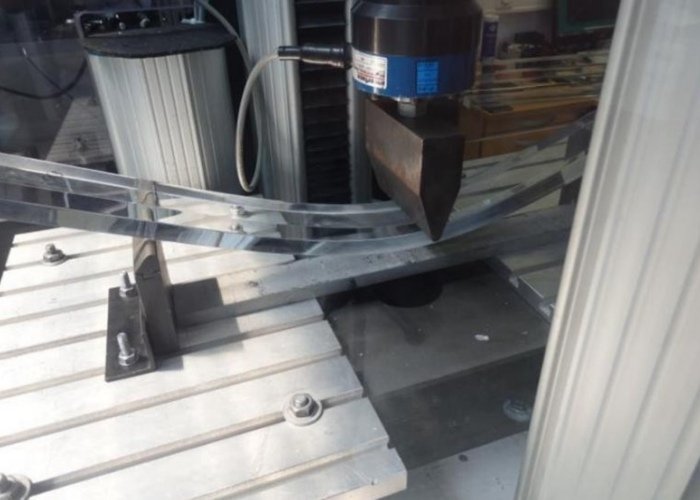
1.The bending and fracture resistance of Aupool acrylic is excellent. In laboratory tests, when the bending deformation reaches 50% of the length dimension, it can maintain this state for 1000 hours without any signs of fracture.
2.The surface of the Aupool acrylic sheet is free from impurities that would compromise its optical properties or appearance.
3.High transparency: Acrylic has a transparency of over 92%, and there is no phenomenon of curved surface refraction.
4.Aupool has the capability and experience to produce ultra-thick sheets with a maximum practical thickness of up to 37 inches.
5.Aupool acrylic sheet has stable material performance, ensuring it does not yellow, fade, or develop silver lines for 30 years of outdoor use.
6.Polished surface: Irregularities on the surface should be minimized, including waviness, ridges, indentations, and protrusions.
7.Impurity tolerance: Each acrylic sheet should be free from inclusions that would compromise its structural performance or damage its optical appearance. Inclusions may include voids, sand particles, hairs, or other forms of foreign matter.
8.No inclusions larger than 0.4 inches are allowed.
Tolerance allowance
A、Sheet length and width:
Below 13 feet:±0.4 inches
Below 26 feet:±0.8 inches
Above 26 feet: ±2.0 inches
B、Sheet thickness:
Below 4Inches: ±0.2 inches
Below 6Inches: ±0.3 inches
Below 8Inches: ±0.5 inches
Below 12Inches: ±0.8 inches
C、Flatness
Plus/minus 0.5% of the acrylic sheet length
When measuring arbitrarily on the horizontal surface of the acrylic, the torsional deformation should not exceed 1/100 of its length.
Aupool produces up to 5000 tons of acrylic sheets annually, equipped with advanced production lines and machinery. It possesses the most mature production capacity and equipment for ultra-thick acrylic sheets, with the thickest sheet in actual use reaching 37 inches. Aupool provides safe acrylic sheet products for numerous design companies, real estate developers, villa owners, and pool contractors.








